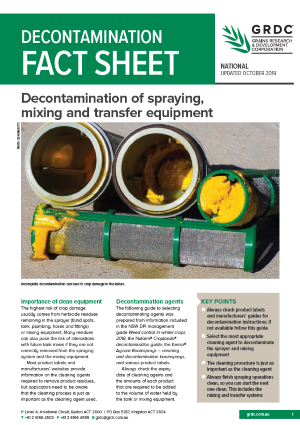Decontamination fact sheet
Decontamination fact sheet
Published: 01 Oct 2019
The highest risk of crop damage usually comes from herbicide residues remaining in the sprayer (blind spots, tank, plumbing, hoses and fittings) or mixing equipment. Many residues can also pose the risk of interactions with future tank mixes if they are not correctly removed from the spraying system and the mixing equipment. Most product labels and manufacturers’ websites provide information on the cleaning agents required to remove product residues, but applicators need to be aware that the cleaning process is just as important as the cleaning agent used.
The following guide to selecting decontaminating agents was prepared from information included in the NSW DPI management guide Weed control in winter crops 2018, the Nufarm® Croplands® decontamination guide, the Kenso® Agcare Boomsprays – cleaning and decontamination boomsprays, and various product labels. Always check the expiry date of cleaning agents and the amounts of each product that are required to be added to the volume of water held by the tank or mixing equipment.
Key points
- Always check product labels and manufacturers’ guides for decontamination instructions; if not available follow this guide
- Select the most appropriate cleaning agent to decontaminate the sprayer and mixing equipment
- The cleaning procedure is just as important as the cleaning agent
- Always finish spraying operations clean, so you can start the next one clean. This includes the mixing and transfer systems.
Download PDF
Region: National

